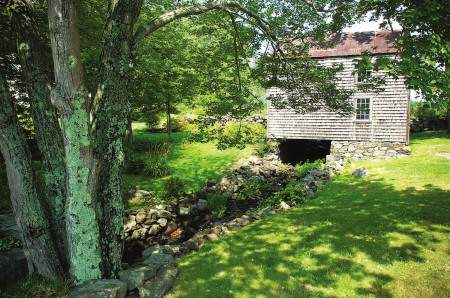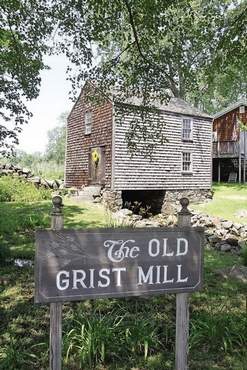Movement Aims to Preserve Link to Colonial Era in Hampton
By Patrick Cronin
Seacoast Sunday, August 5, 2012
[The following article is courtesy of the Seacoast Sunday and Seacoast Online.]

The historic Grist Mill on High Street, near the intersection of Mill Pond Lane in Hampton.
HAMPTON — Candice Stellmach said her number-one goal is to ensure the Grist Mill is restored to its former glory so that people of all ages can enjoy the only mill left in town for years to come.
The 326-year-old mill, located on High Street near Mill Pond, has been deteriorating over the years. If something isn’t done, the town’s oldest link to the Colonial era could be lost forever, Stellmach fears.
“It’s one of a handful of mills in the state, and it’s a part of the town’s history,” she said.
Hampton voters validated the importance of preserving the town-owned mill, approving a $34,260 petition warrant article at the March 13 election. The money was earmarked to repair the stone foundation, roof, siding and flooring of the mill.
But recently, officials of the Deacon Tuck Grist Mill Committee discovered the repairs needed to the foundation are more extensive and more costly than originally thought.
It is believed the foundation work will take up the majority of the funding available in the warrant article, leaving very little money to do the remaining work.
Selectmen last week gave the Public Works Department permission to apply for a $50,000 matching grant from the New Hampshire Land and Community Heritage Investment Program.
The only caveat is the board would like to see the $34,260 already approved by voters as a match rather than go back to the taxpayers to ask for more money. The town hopes that if the grant is awarded, it will be enough to fund the entire project.
For Stellmach, who lives near the mill, the grant is of high importance because of the mill’s historic significance to the town.
The mill was built by one of the town founders, Deacon John Tuck, in 1686. It was used for 200 years to grind Indian corn into fresh flour and meal, one of the food staples during the Colonial era.
The committee believes the original power source of the mill was a tub wheel, similar to the early wheel used in the Winnicut Mill, which exists only on paper and in photos now.
The Grist Mill has been idle since 1885.
Stellmach said the restoration won’t make the mill operational again, but will help it serve as a museum.
“We don’t want to grind corn, but we do want to enable visitors, especially students, to see and understand the mechanics those colonists designed to survive in the new world,” Stellmach said.
The mill holds a special place in her heart as her family sold the mill to the town for $5,000 in 1960.
“I grew up playing in that mill and have many fond memories,” Stellmach said.
Stellmach said when the committee put forward the warrant article, its members didn’t know the foundation was in such poor condition. A structural engineer was brought in because the committee is in the process of filing paperwork to include the mill on the state Registry of Historic Places.
The goal, she said, was to get on the registry to make the mill eligible to receive grants for a second phase of the restoration project, which would focus on the interior of the building.
The structural engineer, however, recommended that the foundation be fixed before any work is done on the interior.
Noyes said repairing the foundation will cost between $10,000 and $25,000.
“It’s not like a typical foundation repair,” said Noyes, who noted its close proximity to uplands and the river. “There are a lot of challenges to do that foundation and to do it right.”
Noyes said crews will need to jack up the building, dismantle two sections of the stone foundation and replace it with concrete footing and new stone work.
Stellmach said up until March, the town had spent very little maintaining the mill, despite voters approving a warrant article in 1983 to request selectmen to “maintain and keep up” the mill.
The last time voters approved funding was in 1985. Voters at the time approved $5,800 for repairs to the foundation to prevent the historic structure from falling into the small creek that the building spans.
Since then, little has been done.
Stellmach said to gain support for the restoration project, she and committee members plan to continue showcasing the mill.
Last year they hosted a Fairy Fantasia event. Recently, the committee invited artists to visit and paint the lilies around the mill. The committee is working to plan more events.

The historic Grist Mill on High Street, near the intersection of Mill Pond Lane in Hampton.